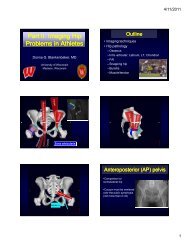Ankle and Foot 47 - Department of Radiology - University of ...
Ankle and Foot 47 - Department of Radiology - University of ...
Ankle and Foot 47 - Department of Radiology - University of ...
You also want an ePaper? Increase the reach of your titles
YUMPU automatically turns print PDFs into web optimized ePapers that Google loves.
<strong>47</strong> <strong>Ankle</strong> <strong>and</strong> <strong>Foot</strong> 2217 <strong>47</strong><br />
Figure <strong>47</strong>-13. Synovial cyst <strong>of</strong><br />
the anterior tibial tendon in a 23-<br />
year-old. Axial (A) <strong>and</strong> sagittal (B)<br />
T2-weighted images demonstrate<br />
the cystic outpouching (white<br />
arrow) <strong>of</strong> the synovial sheath<br />
surrounding the anterior tibial<br />
tendon (black arrow). The tendon<br />
itself is normal.<br />
A<br />
B<br />
proximal aspect <strong>of</strong> the calcaneus. The space contained<br />
within this triangle is filled with fatty tissue, producing a<br />
well-defined lucent triangle that can be seen on lateral<br />
radiographs <strong>of</strong> the ankle (Fig. <strong>47</strong>-14A). On rupture <strong>of</strong> the<br />
Achilles tendon, this space becomes poorly demarcated,<br />
<strong>and</strong> the normally lucent fatty tissue space becomes obscured<br />
(see Fig. <strong>47</strong>-21A).<br />
The Achilles tendon is easily evaluated by physical<br />
examination as well as by MRI or ultrasonography. 23 In the<br />
sagittal plane, the Achilles tendon should appear uniformly<br />
straight <strong>and</strong> black on T1-weighted images (Fig. <strong>47</strong>-14B)<br />
as well as on fluid-sensitive images (Fig. <strong>47</strong>-14C). There<br />
should be a sharp interface between the Achilles tendon<br />
<strong>and</strong> Kager’s fat pad directly ventral to it. A normal retrocalcaneal<br />
bursa may be present just in front <strong>of</strong> the Achilles<br />
tendon (white arrowhead, Figs. <strong>47</strong>-12D <strong>and</strong> <strong>47</strong>-14C). The<br />
normal retrocalcaneal bursa should measure less than<br />
6 mm superior to inferior, 3 mm medial to lateral, <strong>and</strong><br />
2 mm anterior to posterior. 41 Any fluid behind the Achilles<br />
tendon, in a retro-Achilles bursa, is abnormal. In the axial<br />
plane, the Achilles tendon should appear flattened in the<br />
anteroposterior direction. Distally, the ventral margin <strong>of</strong><br />
the tendon becomes concave, with upturned corners resembling<br />
a smile (see Fig. <strong>47</strong>-10D).<br />
Injury<br />
For practical purposes, the plantaris tendon is seldom clinically<br />
relevant in the ankle. Tears <strong>of</strong> the plantaris tendon<br />
tend to occur high in the calf, at the plantaris musculotendinous<br />
junction, <strong>and</strong> have been called “tennis leg.” By<br />
MRI, plantaris tears present as fluid tracking along the<br />
length <strong>of</strong> the calf, between the underlying soleus <strong>and</strong> more<br />
superficial gastrocnemius muscles (Fig. <strong>47</strong>-15). Figure<br />
<strong>47</strong>-16 illustrates a chronically swollen <strong>and</strong> scarred posterior<br />
tibial tendon, with its cross-sectional area greater than<br />
that <strong>of</strong> the normal anterior tibial tendon.<br />
Ruptures <strong>of</strong> the Achilles tendon are usually diagnosed<br />
clinically, <strong>of</strong>ten by the patients themselves. Patients can<br />
<strong>of</strong>ten recall the exact instant the Achilles ruptured, describing<br />
the sensation “as if someone kicked me.” The classic<br />
Achilles tendon rupture occurs with forced dorsiflexion <strong>of</strong><br />
the planted foot, such as occurs in basketball or other<br />
jumping sports. The classic patient is a middle-age<br />
“weekend warrior” who leads a sedentary life <strong>and</strong> attempts<br />
to participate in sports, perhaps with younger players,<br />
without an adequate warm-up. Of all the tendons <strong>of</strong> the<br />
foot <strong>and</strong> ankle, the Achilles is the only one for which disorders<br />
have a male predominance. Complete ruptures <strong>of</strong><br />
the Achilles tendon typically occur at one <strong>of</strong> two locations.<br />
One site is low, 3 to 5 cm just proximal to the calcaneal<br />
insertion (Fig. <strong>47</strong>-17). This is a relatively hypovascular<br />
watershed region. The other site is relatively high, up at the<br />
musculotendinous junction (Fig. <strong>47</strong>-18). These more proximal<br />
tears may require that the imaging coil be repositioned<br />
around the lower calf rather than around the ankle<br />
to visualize the torn <strong>and</strong> retracted proximal end (Fig.<br />
<strong>47</strong>-19). When it is clinically apparent to all that the Achilles<br />
tendon is completely ruptured, confirmation with MRI<br />
is usually unnecessary. However, imaging with MRI or<br />
ultrasonography is used to measure the tendinous gap<br />
between the retracted ends <strong>of</strong> a complete tear.<br />
Partial tears <strong>of</strong> the Achilles tendon are usually intrasubstance<br />
tears, <strong>and</strong> edema-sensitive images reveal increased<br />
signal in a swollen, abnormally rounded tendon (Fig.<br />
<strong>47</strong>-20). Partial tears can also present as nearly complete<br />
ruptures, with only a few remaining fibers intact (Fig.<br />
<strong>47</strong>-21). In these cases, abnormal fluid can be seen surrounding<br />
the intact fibers, within the distended paratenon<br />
(see Fig. <strong>47</strong>-21E). Imaging with MRI or ultrasonography is<br />
used to assess the extent <strong>of</strong> partial tears.<br />
An Achilles tendon that has undergone internal healing<br />
<strong>and</strong> scar formation from a prior intrasubstance tear tends<br />
Ch0<strong>47</strong>-A05375.indd 2217<br />
9/9/2008 5:33:38 PM
















